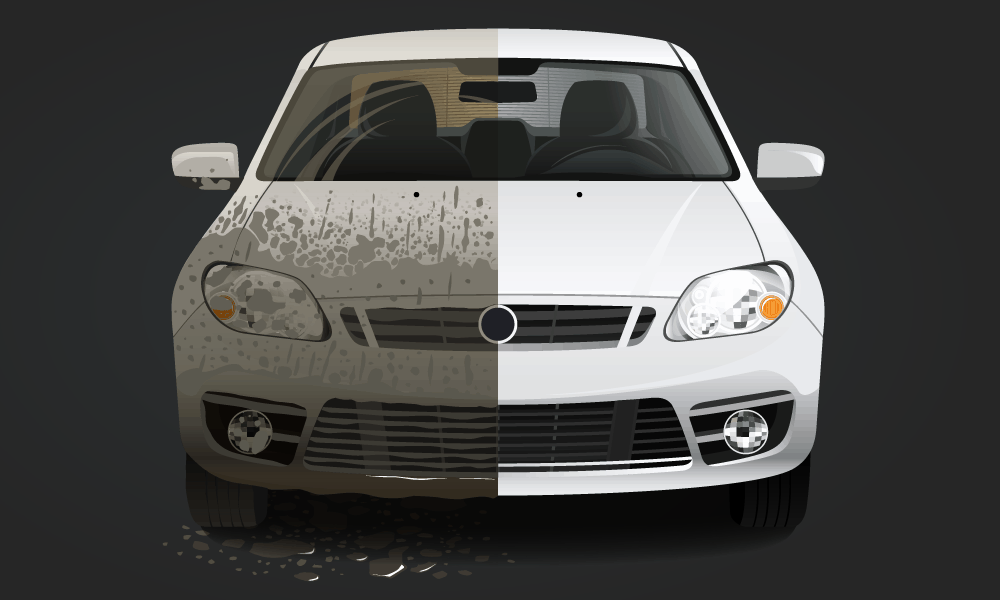Going fast is fun – but slowing down in time kind of important too. It’s amazing how much money us car enthusiasts spend on improving horsepower, air intake and exhaust flow, or bolting on “power adders”. However, without investing in ample brake technology, those performance gains can place you in a ditch.
When you slam on the binders, brake dust is produced. It coats your wheels, suspension components, and yes – even your paint. If it’s left on your car paint, it can infuse onto the clear coat of paint, vinyl materials, and even plastic trim pieces.
So – how do you remove brake dust once it’s stuck on your car paint and other surfaces? That’s what we’ll discuss today. In the information below, we’ll provide some much-needed tips for removing brake dust, industrial fallout, and other iron-based contaminants from your vehicle.
We’ll also explain why it’s a smart idea to slap on a high-quality nano-ceramic coating to protect your vehicle surfaces from exposure.
What Causes Brake Dust?
I’ll assume if you’re on this website, that you have a clear understanding how automotive brakes work. So, I’ll skip the specifics. However, you might not be aware that brake dust is not just the burned residual of brake pads.
Brake dust is a combination of multiple particles, some from the pads, others from the rotors or drum which work together to stop your ride. Some of the ‘ingredients’ with brake dust includes carbon, iron, ceramic materials, plastics, polymers, and even aluminum.
Since there are different materials used in brake pads and rotors/drums, the level and type of brake dust will vary significantly. This represents a rather challenging situation and interesting question – is there a one-size-fits-all method for removing brake dust from your vehicle?
Technically and optimally speaking – the answer is a resounding hell no. But we’ll discuss that in a bit.
Where does Brake Dust Collect or Build-Up on a Car?
There are some trouble spots that tend to collect brake dust more than others. Obviously, the wheels are your leading source of brake dust collection. Depending on the material of the brake components, and that of the surface where its bonded, brake dust can either be a light surface dust or embed onto the material.

It’s also quite common for brake dust and other iron-based metallic debris to stick to the rear end of vehicles. This is due to a low-pressure zone that is created as a vehicle accelerates down the road. But there is another scientific property that helps ferrous-based substances to stick to your car’s metallic body parts – magnetism. We’ll explain that shortly.
Different Methods for Removing Brake Dust from Automotive Surfaces
This is where the challenge exists. Removing surface or light brake dust can be completed by using the good old two-bucket method of car washing. At this stage, brake dust is no different than industrial fallout, dirt, or debris. It just sits on top of the clear coat of paint and is simple to wash away.
The longer it sits, it can begin to stick or embed itself into the material. This mainly happens on metallic surfaces, as most brake dusts is comprised of microscopic levels of ferrous-based materials or those comprised of steel or iron substances.
Since many brake rotors are made from steel or iron, and some pads are semi-metallic comprised of similar materials, as they create friction, electrons are stimulated and can become magnetic.
So, in order to remove brake dust that is stuck onto metal, you must get creative or introduce some chemistry. This is where those iron removal or rail dust sprays come in quite handy.
Essentially, these products are pH neutral chemical formulations that work by reacting with surface contaminants, mainly those that have microscopic levels of iron or steel. It loosens the brake dust and industrial fallout over a few minutes of exposure, is agitated with a sponge or wash mitt, then can be sprayed off.
There are some that contain a color-based activator that will “change colors” on the surface, to show you it’s working. This isn’t magic or a result of the metals “melting” – it’s just an optics-enhancer. However, it does look cool.
Can You Use Wheel Cleaner on Car Paint?
That would not be a good idea. Most wheel cleaners are highly acidic substances, that are intended to be used on solid metals as opposed to clear coated paint applied on metals.
The low pH levels in wheel cleaners works by dissolving brake dust and contaminants. It’s then agitated with a brush or wash mitt, and then sprayed off or wiped off with a microfiber towel.

Most automotive detailing experts (and us too) recommend washing wheels first – before your vehicle’s paint. If you use a wheel cleaner, or have brake dust sprayed off your wheels, it’ll stick to the vehicle’s paint surface. If you wash the paint last, it’s easier to remove that dust or acidic wheel cleaner. If you don’t, it’ll likely stick to your paint and cause damage.
Can You Reduce Brake Dust?
One of the biggest myths in automotive maintenance is that if your car has a lot of brake dust on the wheels, your brakes are about to fail. That’s just not true. Every time you apply brakes, the pad connects with the rotor (on disc brakes) or the brake lining (on drum brakes) – friction is created. This produces heat and causes materials to burn off. The residual produced is brake dust.
Now, there are some things you can do to reduce the production and build-up. Let’s focus on production of brake dust first.
The first thing you can do is swap out brake components. There are some brake systems that are ceramic in nature, that do not contain ferrous materials. Carbon Fiber brake systems are likewise non-ferrous materials. They’ll produce a ‘dust’, but it’s less prone to stick to metal. Kevlar brakes are also good at reducing brake dust.
Here is the dilemma – certain brake systems can’t be changed. For example, many ABS systems on modern cars, trucks, and SUVs require specific replacement parts in order to work as engineered. Replacing materials that are not recommended by the manufacturer is a surefire way to have a brake system failure.

There are other ideas, such as keeping those OEM brake dust covers on your vehicle. Some car enthusiasts are hell-bent to take stuff off their rides that are not visually appealing. When they install custom wheels, the brake dust cover is usually the first item to be removed.
Whether it’s due to clearance issues (most of the time) or an aesthetic removal, they seem to think they know better than engineers who design these rides. So, if this is you – have at it, bro. You’ll just be spending more time and money on removing brake dust from your ride.
There are also brake dust inhibitor sprays. All I’ll say for these products is manipulating the physical attributes of your brake materials isn’t conducive to safety. So again – if you’re inclined – you do you.
How to Remove Brake Dust from Car Paint
OK – so now we’re going to dive into the process of removing brake dust from car paint. Again, there are two situations that will dictate how you remove brake dust. First, if it’s light dust, that hasn’t stuck to your clear coat or metallic surfaces, you’re good to go with a regular two-bucket car wash.
If it’s stuck, there are two proven methods for removing brake dust from paint.
Step One – The Clay Bar or Clay Mitt Method
A clay mitt or clay bar is a special formulated clay that is rubbed on a vehicle surface to remove small particles that are stuck. There is a recommended method for completing this process.

- Gather your supplies: To clay a vehicle correctly, you’ll need a high-quality clay bar or clay mitt. For brake dust particles, a medium-grade clay will work just fine. You also need to have a good clay lubricant spray. I don’t recommend making your own clay lube, as if you don’t get it right, it’ll pit your clear coat.
- Wash the whole vehicle first: Once you’ve collected all your claying supplies, wash your car by using the two-bucket method. Make sure you completely dry the vehicle as well.
- Apply the clay lube spray liberally: Seriously, you can’t use enough lubricant. The more the better. The key is you don’t want the clay to grab onto the surface. It should glide over it, which will remove those brake dust particles without damaging the paint surface.
- Glide the clay bar or clay mitt over the section: It’s best to work in small, square sections. I recommend starting with 4-feet by 4-feet. Just make sure to keep spraying lubricant as you go – keep that surface lubed.
- Rinse off: When you’re done with each section, rinse it off with your spray hose.
- Finish the vehicle then rewash and dry: This is the step that most miss. Here is the deal, clay lube is essentially a 50/50 mix of car wash soap and distilled water. This makes it very concentrated, so it’ll want to stick to the surface. If you don’t wash the vehicle again – using the two-bucket method, that concentrated soap is gonna stick – making your car look horrible.
Step 2 – Using Iron Removal Sprays
If claying isn’t your cup of tea, might I recommend using a dedicated iron removal spray. Here is the key – it’s got to be a pH neutral formulation. Don’t use a product that is acidic, as this will wreck your clear coat very quickly – especially if it’s not protected with a ceramic coating or other paint protection product.
Now, I’m not going to give you a detailed step-by-step process for this method. The reason why is that these products are not all the same. While the basic chemistry is similar, each brand or product has unique steps or formulations in some cases. So, you should always follow the exact steps as directed by the product you use.
Can You Protect Your Car from Brake Dust?
Abso-freaking-lootly. OK, so that’s not a word, but I think you get the point.
Brake dust is a contaminant – plain and simple. It is more likely to bond with bare metal (like wheels for example) but can stick to clear coats, windshields, even headlight covers. To reduce this from happening, consider applying a high-quality nano-ceramic coating – like Armor Shield IX.
When you use a DIY nano coating, it bonds directly on top of the surface, creating a very hard protective layer. Once it cures, that layer is ultra-smooth and flat, making the surface hydrophobic AF. This basically makes brake dust bounce off the surface, not stick to it.
It can be used on anything that is porous and solid – like wheels, body panels, headlight covers, rear spoilers, brake light covers, and even carbon fiber, vinyl and paint protection film. Basically, if it’s on your ride, you can apply a nano coating on top.
Wrapping it Up
Brake dust is an inevitable byproduct of a mechanical function that your vehicle completes daily. Taking proactive measures to protect your vehicle with a durable coating that repels brake dust from sticking is a smart and cost-effective way of reducing brake dust removal headaches.













1 comment
Paul Rasole
I coated my 2019 Chevy 4500 cab and chassis unripened green metallic I’m in totally shock how great it came out
Excellent product again I love how my work truck looks
Thank you
I coated my 2019 Chevy 4500 cab and chassis unripened green metallic I’m in totally shock how great it came out
Excellent product again I love how my work truck looks
Thank you